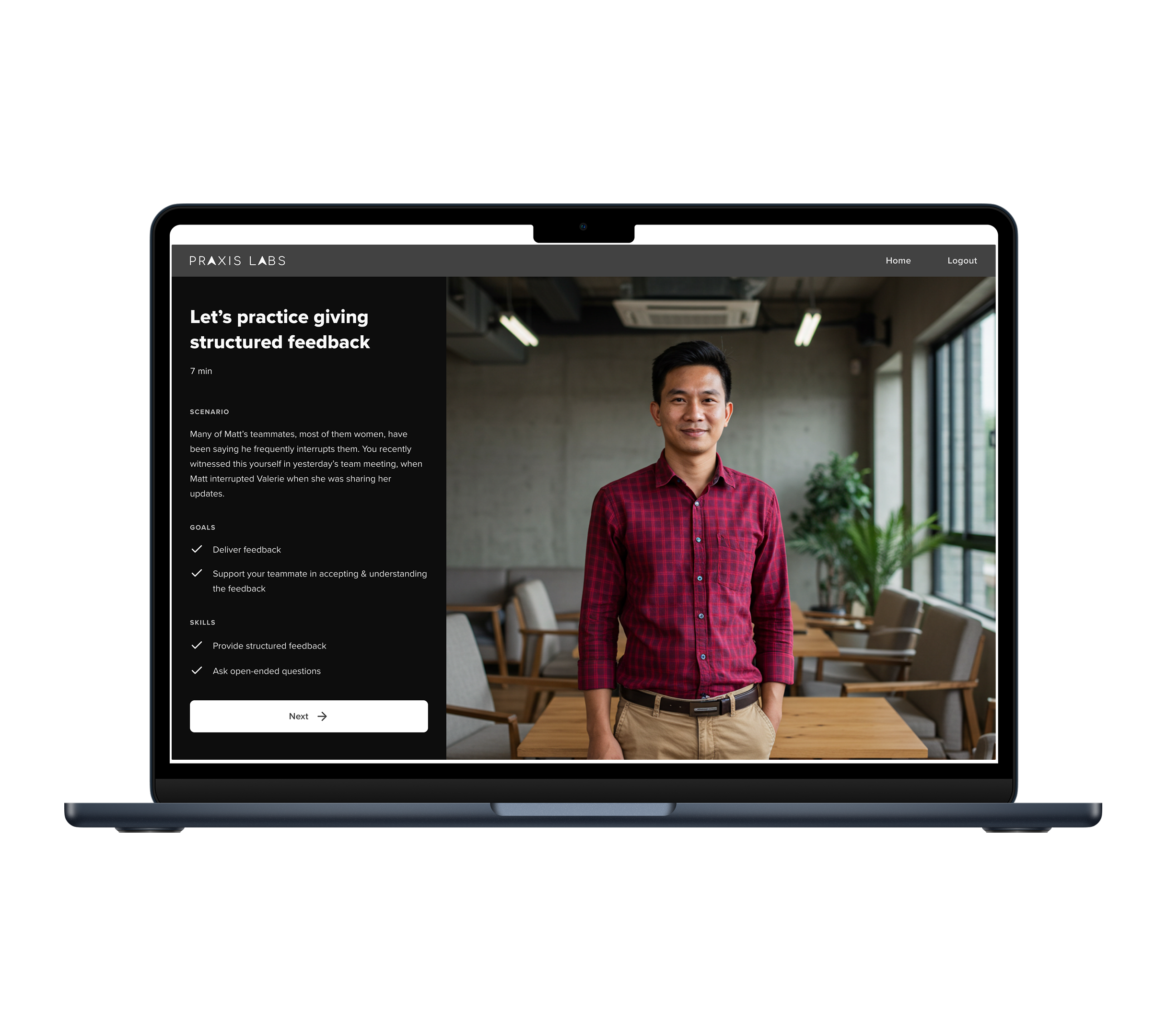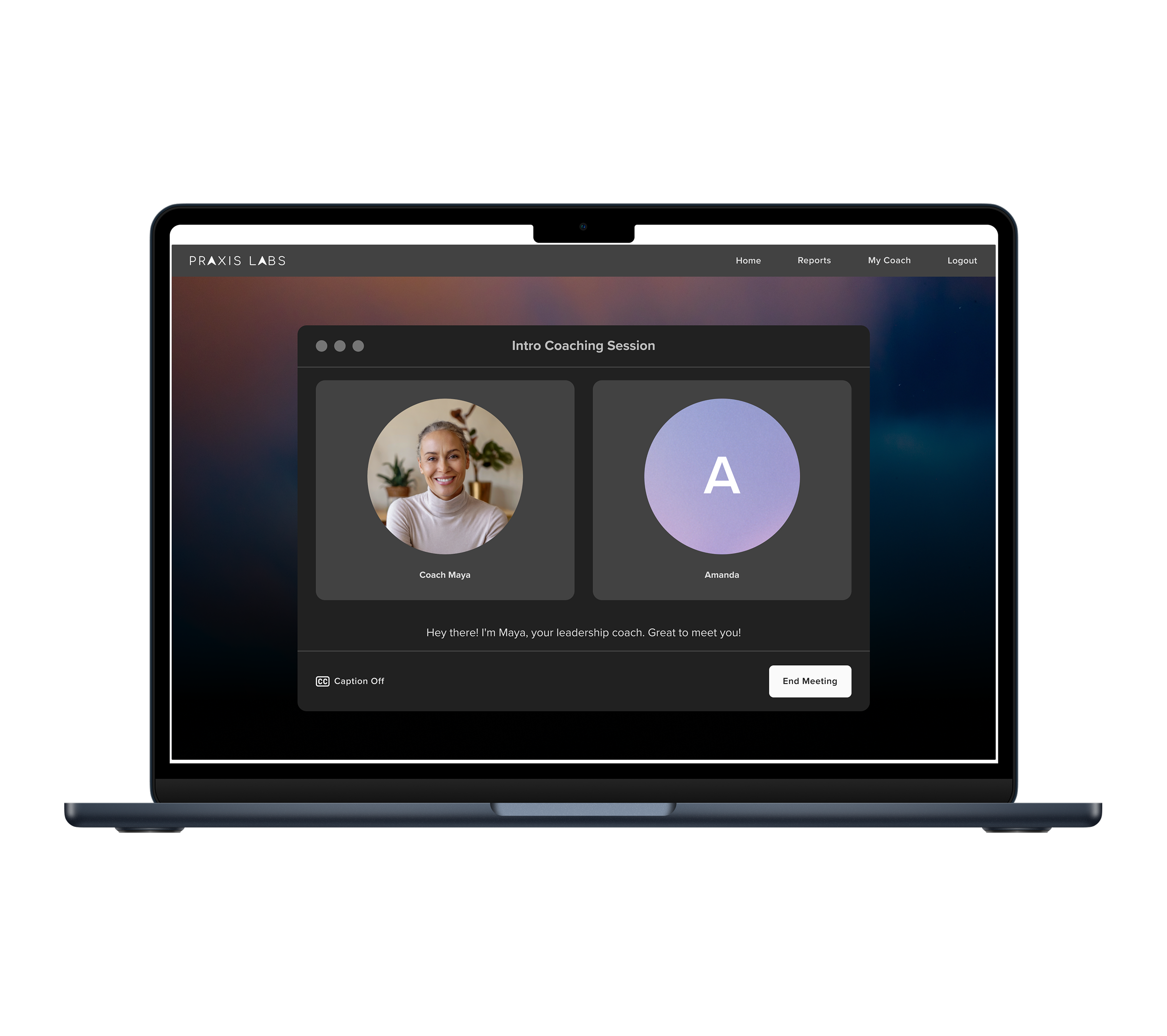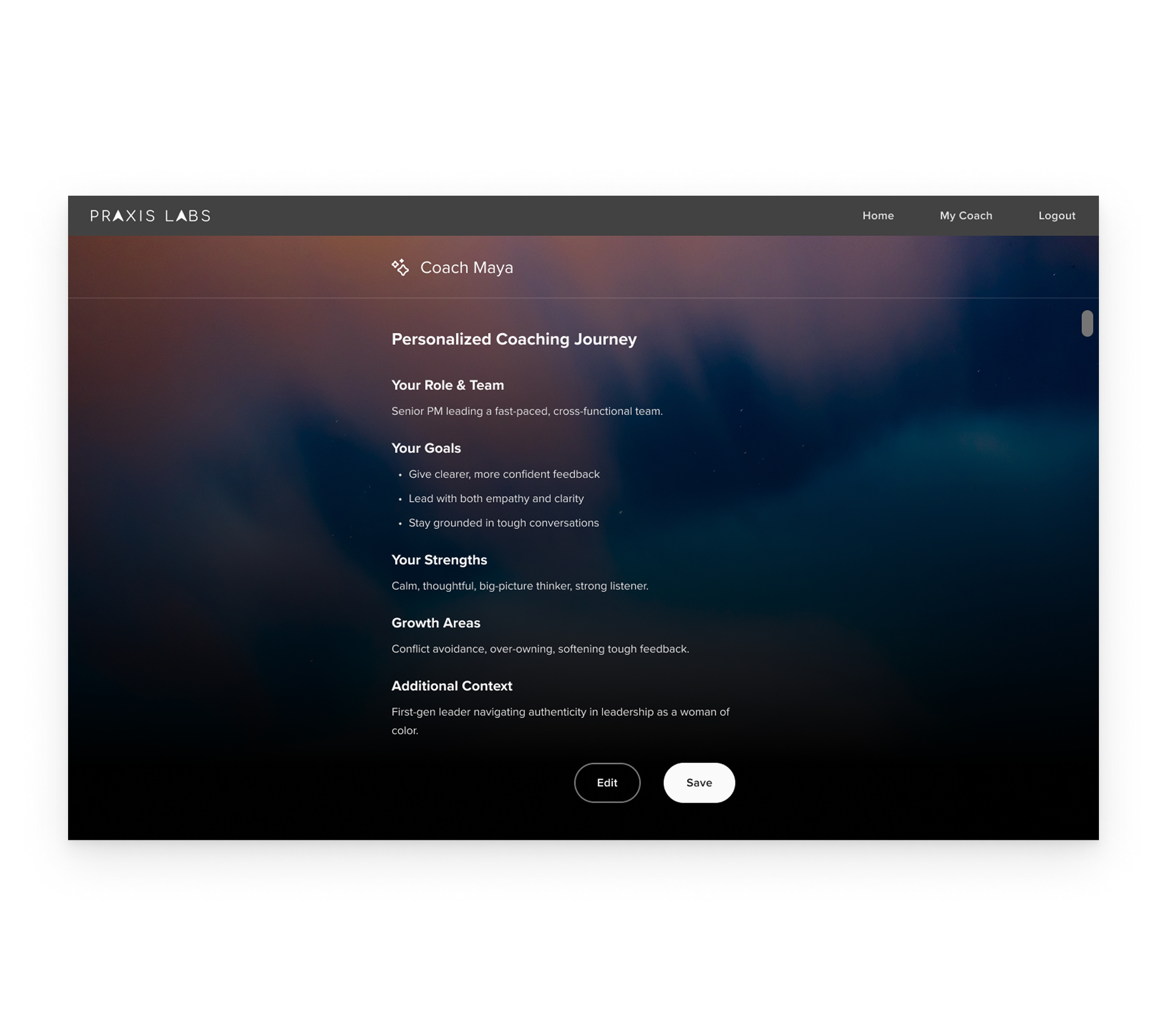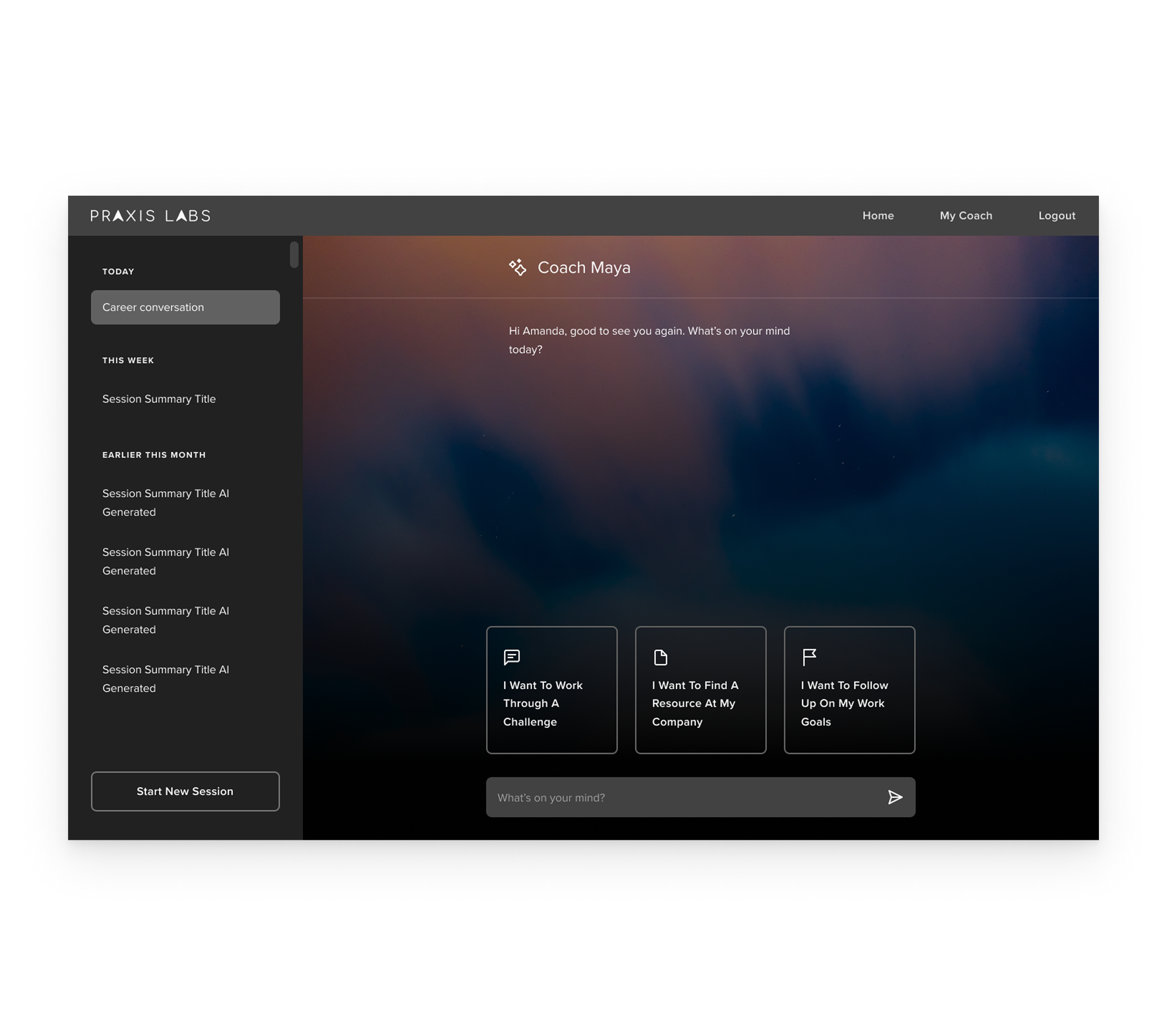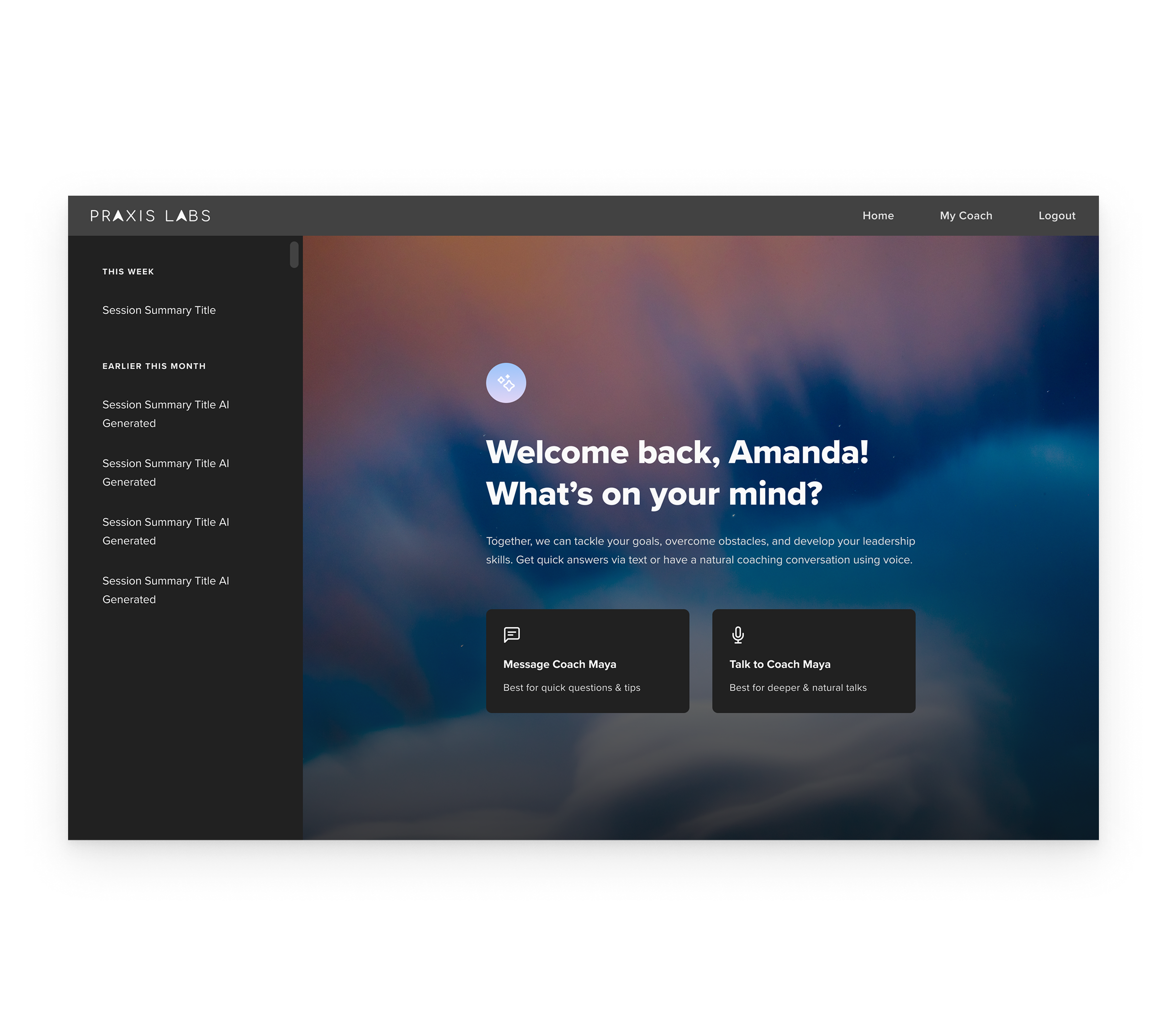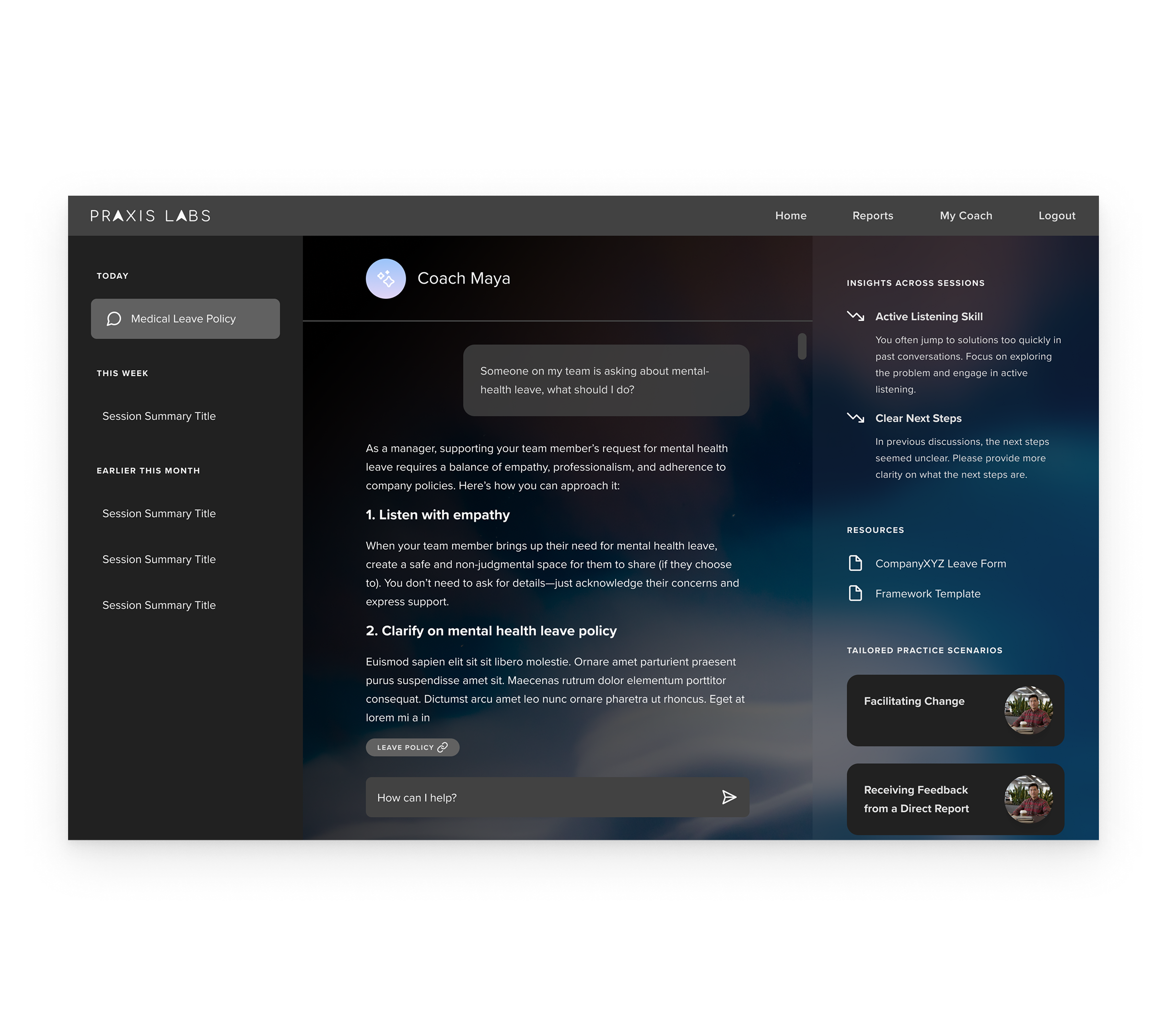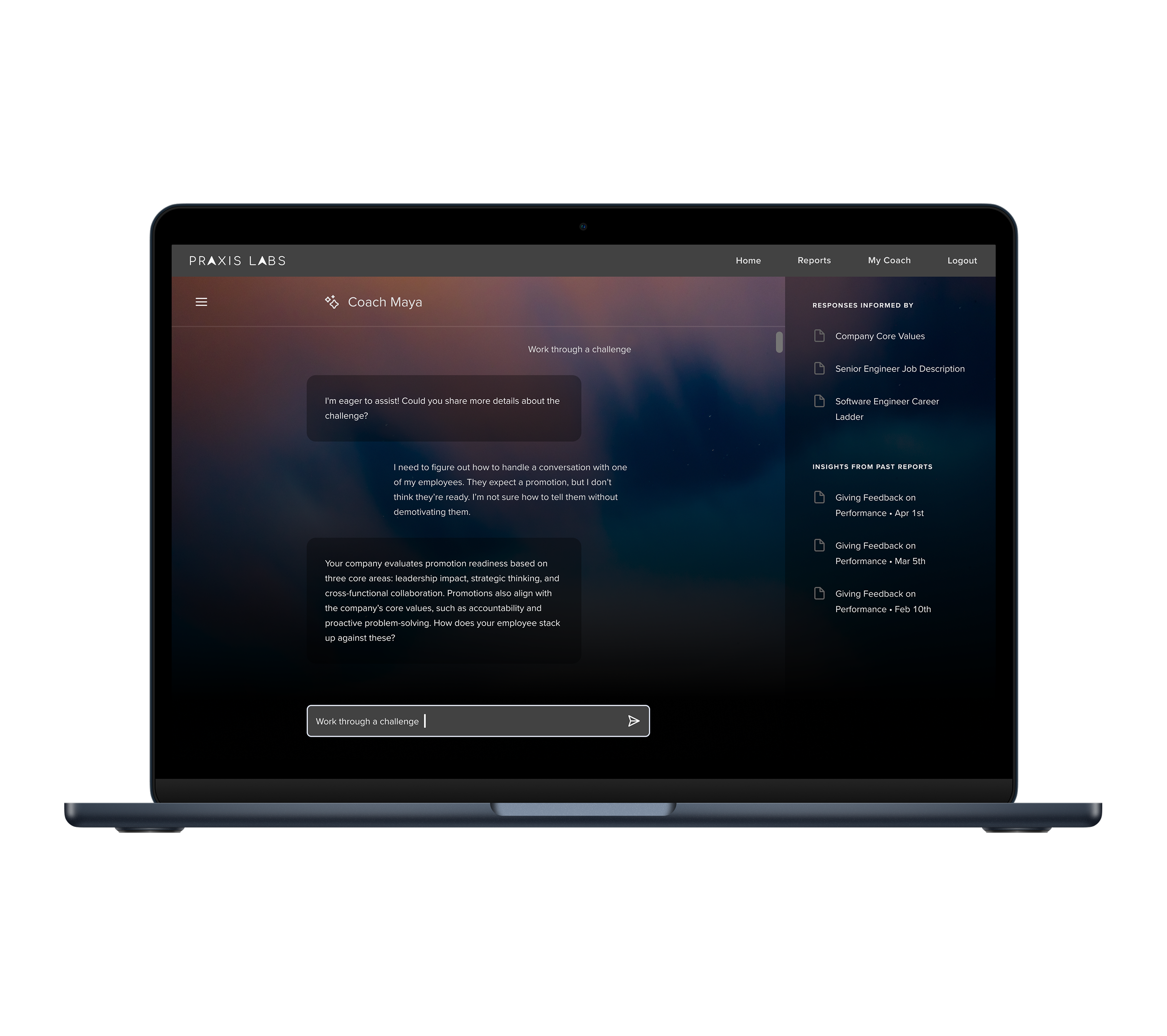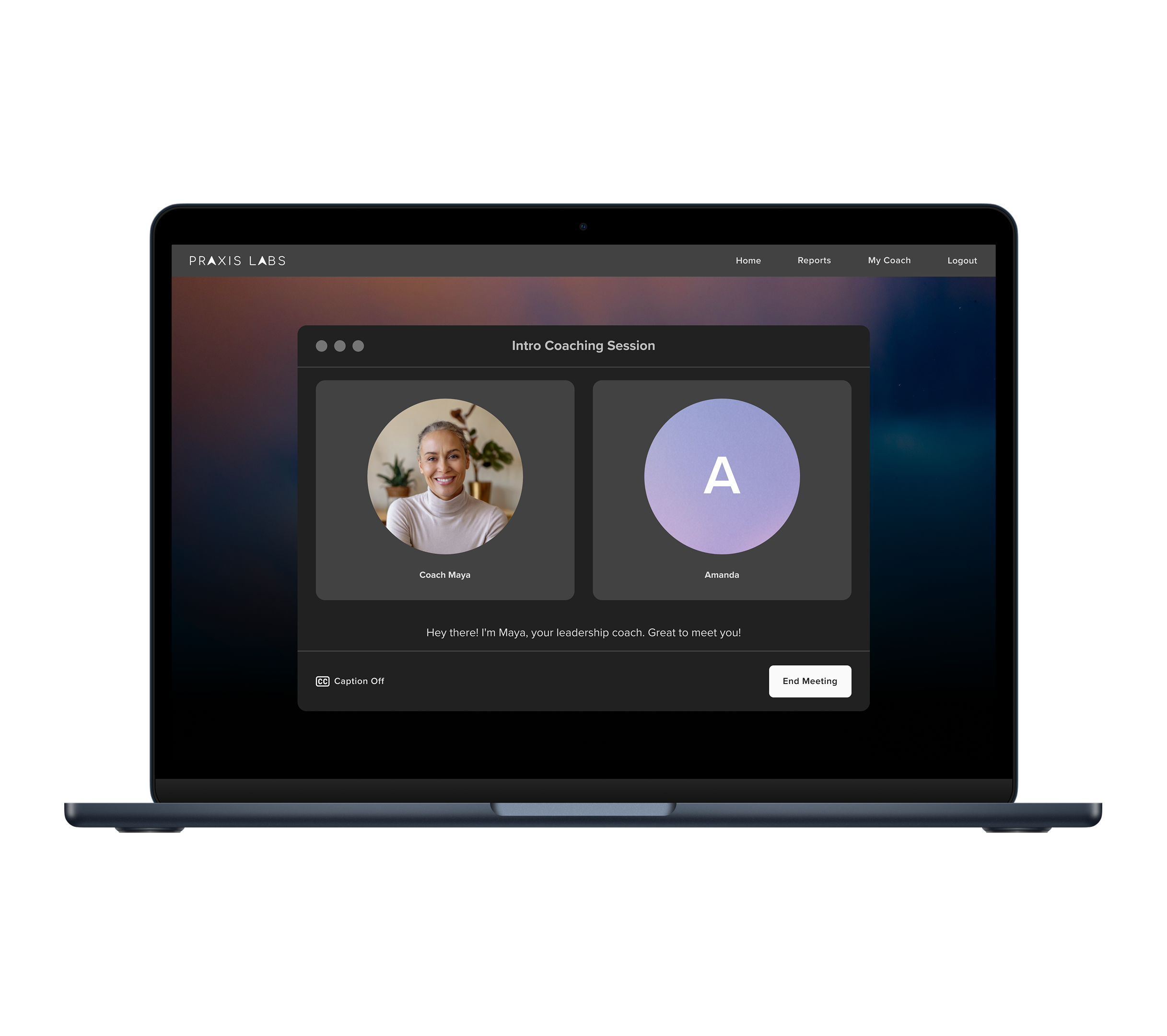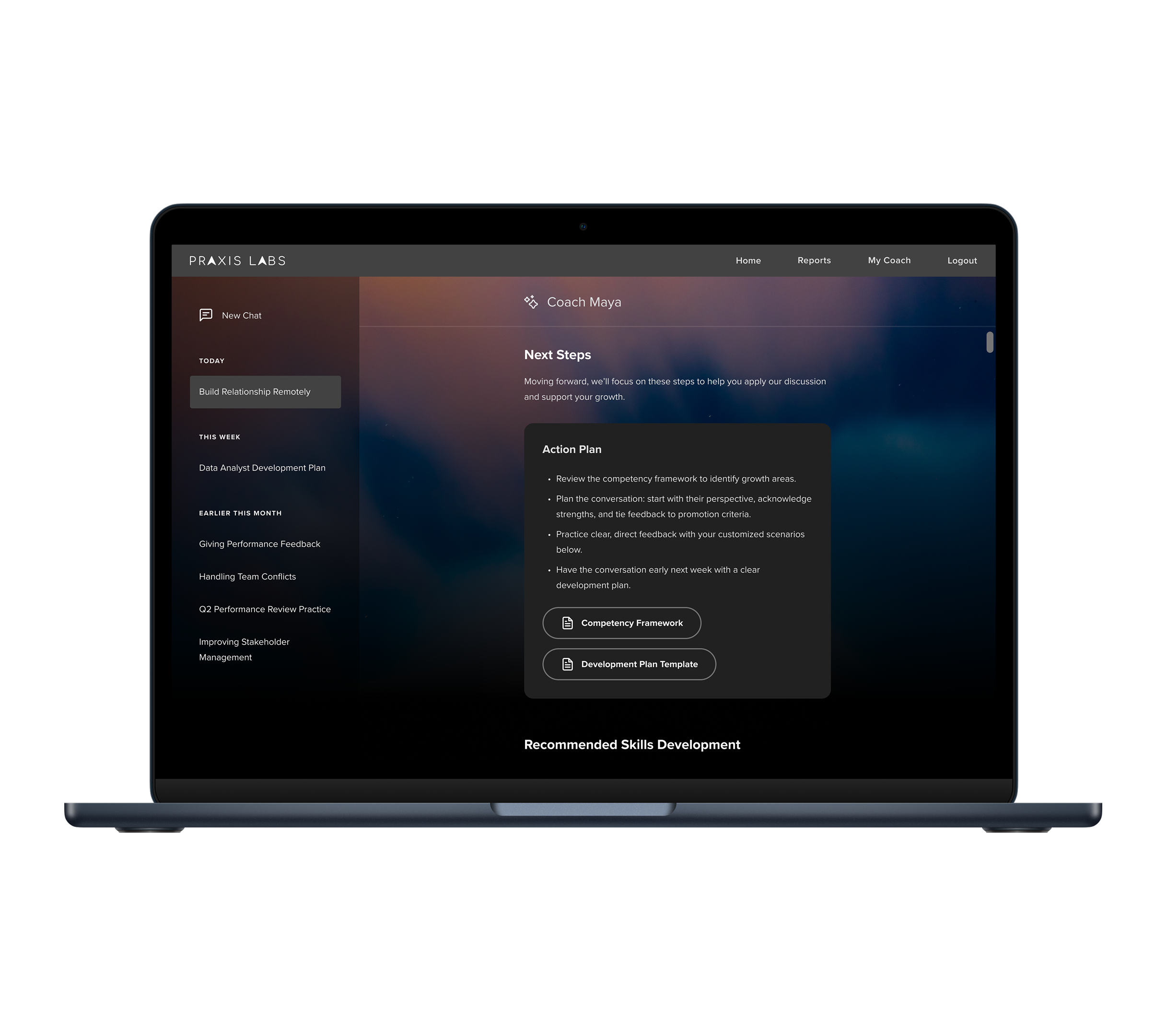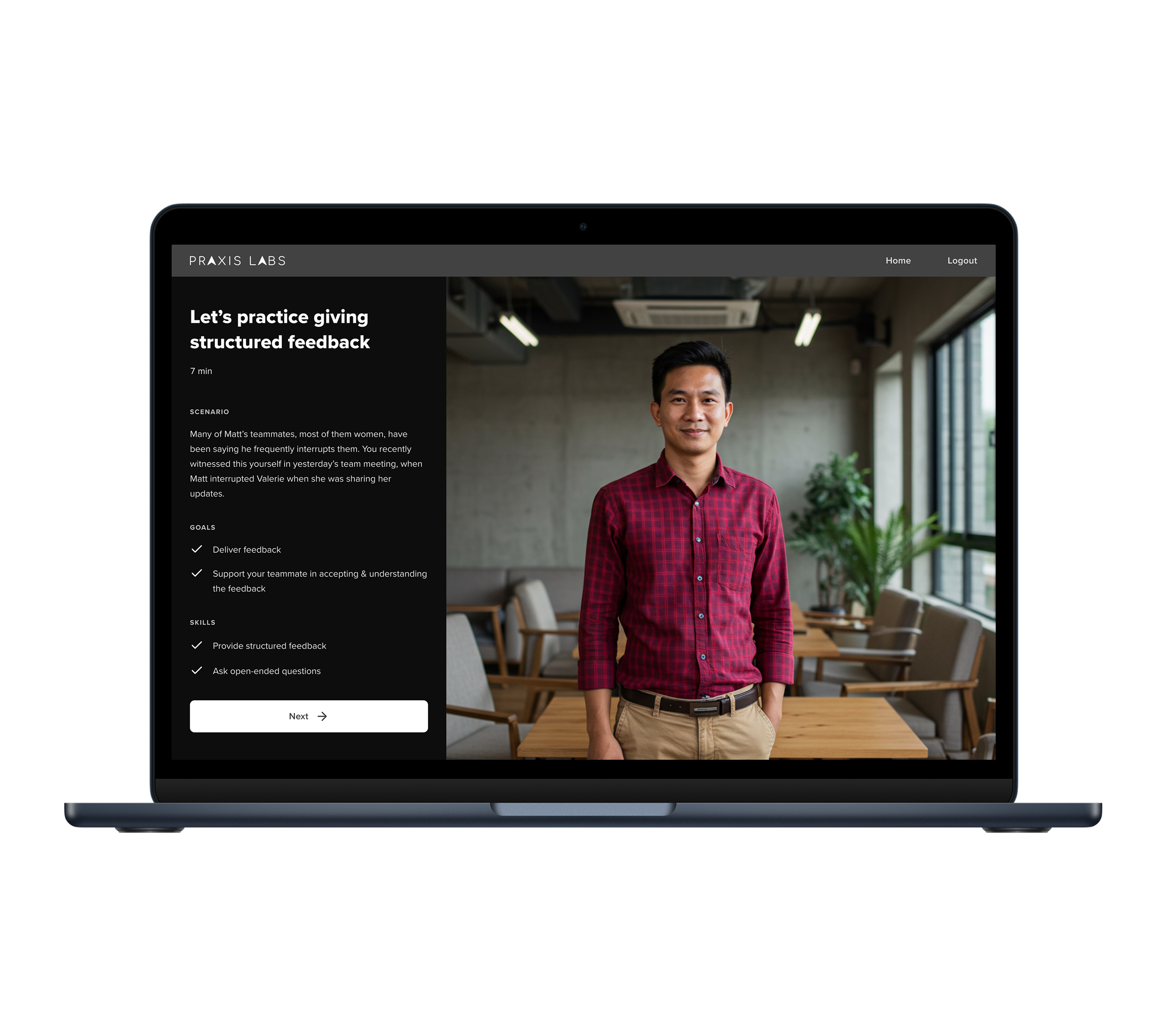Designing Coach Maya an AI Coach for Just-in-Time Leadership Support
Managers face their hardest leadership moments alone—giving feedback, navigating conflict, learning to delegate. Coach Maya delivers support in those moments through an AI coach that remembers your goals, adapts to your style, and creates custom roleplays for real challenges. As the sole designer, I led Maya from concept to enterprise launch—reaching 1,000+ learners, 350+ sessions in month one, and helping drive Praxis Labs’ acquisition by Torch.
About Praxis Labs
Praxis Labs is an AI-powered learning platform on a mission to make workplaces work better for everyone. Through coaching, roleplay, and skill assessment, we help people develop the critical human skills needed to succeed as leaders. Organizations use our platform to build these skills at scale and drive higher engagement and performance.
About Coach Maya
Coach Maya is an AI-powered coach that supports managers in the moment — via voice or text. She remembers goals, adapts to each user’s style, and offers warm, actionable guidance through real leadership challenges.
roleAs the sole designer, I shaped the vision and experience across UI, conversation flow, and AI behavior design. I partnered with product, engineering, and learning science to turn early prototypes into a live coaching product used by enterprise managers.
TeamProduct Designer
Product Owner
2 Learning Designers
2-3 Software Engineers
1 QA Engineer
ResponsibilitiesProduct Design
Visual Design
Conversation Design
AI Behavior Design
Usability Testing
design processDiscover
Partnered with clients, ran interviews, and analyzed early signals to uncover where managers needed the most support.
Define
Framed the problem and success criteria. Focused on making AI coaching distinct from generic chatbots by emphasizing warmth, memory, and actionable strategies.
Develop
Built and tested multiple prototypes. I designed flows, visuals, and conversation norms. We refined in weekly usability loops.
Deliver
Shipped an alpha within two weeks, followed by a beta with enterprise clients, bringing Maya into live use across 1,000+ learners.
01
Discover
The Problem
Managers face their most challenging leadership moments without support in the moment. From client requests and early interviews, three needs stood out:
Timely support — coaching right before or during critical conversations.
Adaptive guidance — tailored to role, goals, and company culture.
Human connection — an AI that feels warm and safe while still offering concrete strategies.
02
Define
The Challenge
Pivotal Practice proved the value of dynamic roleplay, but also revealed limits:
Clients expected more than scenario-based practice.
Learners wanted Maya's coaching available anytime, not just in roleplays.
We needed to differentiate from other coaching and learning platforms by offering a more personal, contextual, and always-available experience.
Our Approach
To meet these needs, we designed Coach Maya to be:
Always-available and just-in-time — accessible right before or during real leadership challenges.
Memory-aware and contextual — recalling past sessions and adapting to each company's culture, values, and policies.
Warm but structured — grounded in proven coaching frameworks to feel human while delivering actionable strategies.
03
Develop
Evolving the ExperiencePhase 1: Concept Validation
Phase 2: Product Refinement
Phase 3: Alpha Release
Tested early prototypes with buyers and clients to validate core experience flow and solution.
Fast 1–2 week design–build–test cycles. Usability tests with success targets:
80%+ ease of use
70%+ coaching helpfulness
70%+ memory recall
70%+ would continue using
40%+ “very disappointed if removed”
Shipped a working prototype in two weeks with voice + text coaching, memory, and summaries. Generated early LOIs, including from coaching companies.
Phase 4: Beta Release
Expanded with client pilots (Uber, ADP, Accenture). Logged 150+ sessions in the first two weeks, with themes around feedback, delegation, and performance.
early versionIntro Session
Early testing showed intake didn’t meet expectations. Managers came in ready for coaching but got a scripted interview that felt like paperwork. Even after I refined the flow — adjusting order, softening prompts, and redesigning the summary — it still fell short.
We reframed intake as a real coaching session:
Maya wove role, strengths, and goals into the conversation naturally.
Sessions ended with next steps, a recommended roleplay, and details Maya would remember for future sessions.
Quick-start shortcuts appeared on the landing page for easy re-entry.
By turning intake into coaching, we reduced friction and made the first chat feel valuable.
Coaching Style
Early prototypes leaned too heavily on reflection, making sessions feel slow and repetitive. Learners wanted a clearer balance of empathy and action.
We grounded Maya in the iGROW framework (Goal, Reality, Options, Way Forward) and added a choice of coaching style:
Reflective for deeper self-awareness
Tactical for step-by-step planning
This made sessions more predictable, actionable, and differentiated from generic chatbots. Learners described them as “structured but flexible,” and enterprise clients valued how Maya could adapt style to context.
early versionChat Interface
Another challenge was creating a text-based interface that felt distinct from ChatGPT while still leveraging familiar chat patterns for usability.
To strike the balance, I:
Adjusted layout and details while keeping core conventions intact.
Added calming visuals — an abstract sunset fading into a starry night.
Used subtle symbolism — a star icon for AI, the day-to-night shift for reflection and change.
This approach gave Maya a distinct look and feel while keeping the conversation UI intuitive and comfortable for learners.
early versionConversation UX
Early tests showed that Maya’s sessions could feel unfocused — with long reflections, stacked questions, frequent interruptions, and repetitive affirmations. Some learners dropped off when sessions didn’t quickly move toward actionable guidance.
We established clear conversation norms:
One question at a time
Shorter turns, keeping the learner talking ~80% of the time
A concrete suggestion by turn three
Fewer and more varied affirmations
Minimal restatement
This reduced repetition loops and built trust. Learners described the flow as “clearer and more natural,” and session metrics showed fewer early exits in mid-beta.
early versionVoice & Text Mode
Early feedback showed a split. Voice was immersive but slowed by long pauses and affirmations. Text was clearer for tactical coaching but felt too generic and light on co-creation.
I drove improvements:
Voice — upgraded to Hume EVI3 + Claude for smoother pacing, tone variation, and better interrupt handling
Text — refined prompts to surface memory and proactively co-create outputs (e.g., development plans), which learners rated higher in testing
Both — added a suggestion by turn 2–3, reduced reflection loops, and varied affirmations
Supporting both gave managers flexibility: voice for realistic conversations, text for quick planning. Learners called the improvements “structured but not scripted.”
early versionUser Memory
In early prototypes, every session started fresh. Without memory, Maya risked sounding generic — more like ChatGPT than a coach. Learners wanted continuity: someone who remembered their role, goals, and past challenges.
We introduced user memory to personalize coaching:
Maya generated a clear memory summary after each session
Learners could review and edit this memory for accuracy and control
Future sessions drew on it, letting Maya tailor guidance and adapt over time
Memory made coaching feel more engaging and personal. 81.8% of learners found memory recall helpful, and one manager shared: “I loved that Maya remembered what I told her last time — it felt like she knew me.”
early versionContext Recall
Early prototypes felt too generic, limiting perceived value. Enterprise clients wanted Maya to adapt to their company language, policies, leadership frameworks, and values.
We integrated RAG (retrieval-augmented generation) so Maya could ground coaching in organizational context:
Designed a context panel to surface resources (e.g., values, job descriptions, performance rubrics) when referenced.
Drew on company leadership principles, frameworks, and policies in real time.
Framed org-specific knowledge as Maya’s own expertise, not external “documents.”
Amazon, Uber, and Salesforce explicitly cited org-aware context as key to adoption, validating RAG as a differentiator for enterprise scale.
Designing Maya
Another challenge was how Maya should look and feel. A faceless coach felt cold; a lifelike one risked false intimacy or bias. I wanted her to feel warm without prescribing an identity.
I resolved this by:
Drawing inspiration from real people — Maya’s original voice actor and our head of curriculum.
Balancing lifelike design with responsibility, avoiding false intimacy.
Starting with a default coach, while giving learners the option to choose a custom one over time.
The result is a coach who looked human and lifelike, yet felt safe, trustworthy, and adaptable for diverse learners.
early versionCustom Roleplay
Learners wanted to practice with their own situations. Our first attempt inside Pivotal Practice created friction, so we moved customization into Maya, making it simple and engaging.
Context-driven — Maya asked short questions to capture the challenge.
Adaptive — she flexed between modifying existing or creating new roleplays.
Unlimited practice — learners could rehearse situations that matched their work.
We added “Practice a Conversation” as a chip on Maya’s landing page. In user testing, it emerged as a top feature, helping learners connect coaching directly to their real challenges.
early versionSession Summary
The early prototype didn’t include a summary after voice sessions, leaving learners unsure of next steps. Many wanted a way to take notes or revisit the conversation later.
We redesigned the wrap-up as a structured, actionable summary:
Offered concrete next steps tailored to the learner’s challenge.
Recommended a roleplay to keep learning active.
Included a transcript for review and reflection.
Wrap-ups quickly became one of Maya’s most valued features. Beta tests showed wrap-up engagement correlated with higher likelihood of re-engaging within a week.
04
Deliver
Learner Journey Walkthrough
After rounds of testing and iteration, Coach Maya emerged as a seamless coaching experience designed for trust, ease, and quick value. The learner journey flows through five core touchpoints:
Landing Page
Text Mode
Resource Reference View
Voice Mode
Custom Roleplay
Session Summary
Landing Page
Learners arrive on a personalized home screen.
New learners begin with a short intro chat that seeds Maya’s memory.
Returning learners see memory chips to pick up past goals or start a new session in voice or text.
The design keeps entry low-friction and immediately relevant.
Text Mode
A fast, structured option for tactical needs.
Inline memory recall and resource links keep guidance contextual.
Used frequently for planning, drafting feedback, and preparing for 1:1s.
Resource View
Company context surfaces directly in the flow.
Leadership principles, policies, and templates appear when relevant.
Keeps learners focused while grounding coaching in organizational reality.
Voice Mode
Sessions feel like real coaching calls.
Powered by Hume for emotion detection and Claude for warmth.
Natural cues (“mm,” “gotcha”) make the exchange feel authentic.
Chosen most often for deeper, more immersive coaching.
Session Summary
Every session closes with a structured wrap-up.
Key insights and concrete next steps.
Suggested roleplays or templates to continue practice.
Transcript for review and reflection.
One of Maya’s most valued features, reinforcing progress and re-engagement.
Custom Roleplay
A chip on Maya’s landing page let learners practice their own situations.
Maya captured the challenge with a few quick questions.
Adapted existing scenarios or generated new ones as needed.
Became a top entry point, helping managers prepare for real conversations.
05
Impact
Coach Maya proved that just-in-time AI coaching can deliver real value to both managers and enterprises — driving measurable learner growth, fueling strategic client expansion, and positioning Praxis Labs as a leader in AI coaching.
Market Signal
Learner Impact
Business Outcome
Across clients, a clear pattern emerged: Maya is no longer a pilot experiment. She’s being scaled into leadership programs, embedded into company frameworks, and tapped for strategic insights — validating her role as a differentiated, enterprise-ready coaching solution.
Maya quickly proved valuable to managers across pilot programs.
350+ sessions in the first month across six enterprises, averaging 8–11 minutes each
Strong repeat engagement: 25+ learners returned for multiple sessions in the first two weeks
Common use cases included feedback, delegation, and performance management
At Accenture, HiPo managers reported 70–77% confidence gains after multiple sessions
Generated three LOIs (Torch, Crucial Learning, Degreed) within weeks of launch
Maya’s traction was a key factor in Praxis Labs’ acquisition by Torch, ensuring long-term investment and enterprise integration
Client Outcome
Enterprise pilots validated Maya’s differentiators and unlocked new pathways for scale:
Conagra — Expanding access with on-demand coaching for all people managers
Accenture — Building new leadership cohorts centered on Maya
Uber — Testing high-value use cases, such as accommodations policy coaching
ADP — Leveraging Maya’s conversation insights to shape long-term L&D strategy
Amazon — Embedding Leadership Principles into Maya’s coaching to increase relevance
Salesforce — Integrating Maya into flagship leadership programs to scale access
Learner Quotes
It actually felt like a real coaching conversation. The pacing was natural, and the tone didn’t feel scripted. It made me stop and think instead of just answering questions. Honestly, I forgot I was talking to an AI after a while.
She gave really useful suggestions that were short and to the point. I liked that she didn’t overexplain — it was like having someone coach me through what to say in my next one-on-one. It made the situation feel a lot more manageable.
I loved that Maya remembered what I told her last time. It felt like she actually knew me and cared about my goals. The summary at the end made it easy to see what we talked about and what to do next — something I wish human coaching apps did better.
06
Learnings
Designing an AI Coach
Frameworks Build Structure
Visible Memory Builds Trust
Wrap-Ups Reinforce Value
Grounding Maya in iGROW made coaching credible and focused. Pure empathy felt vague, but frameworks provided clarity and actionable outcomes.
Learners wanted continuity across sessions. Making memory visible and editable reassured them that Maya was accurate and safe to use.
Without closure, sessions felt incomplete. Structured summaries with insights and next steps became one of Maya’s most valued features.
Designing for Conversation
Prompting Shapes Flow
Details Create Human-ness
Conversational UX hinged on prompt design. Clear pacing, one question at a time, and balancing reflection vs. action kept sessions productive.
Voice tone, varied affirmations, and natural pauses made Maya feel alive, while stacked reflections or robotic breaks quickly broke the illusion.
Working with AI
Guardrails Tame Unpredictability
Relentless Voice Testing
Ship Fast, Refine Faster
Design for unpredictability. Fallbacks and guardrails protected the learner experience when the model wandered.
Test relentlessly. Voice UX in particular required fine-tuning — every pause, phrase, and handoff affected trust.
Move fast, learn fast. We shipped an alpha in two weeks, tested in the wild, and refined based on every frustration and delight we observed.
Collaborate Deeply
I paired with engineers, learning scientists, and Hume to refine prompts, guardrails, and pacing. Cross-team input made Maya feel human.



